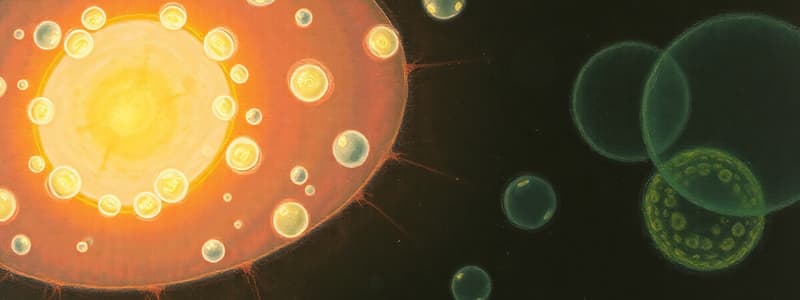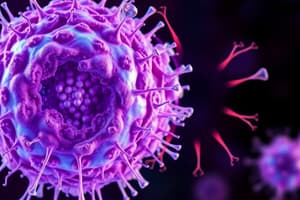Podcast
Questions and Answers
Which of the following is a key difference between prokaryotic and eukaryotic cells?
Which of the following is a key difference between prokaryotic and eukaryotic cells?
- Prokaryotic cells are larger and more complex.
- Prokaryotic cells are simpler and smaller. (correct)
- Eukaryotic cells contain sub-cellular structures.
- Eukaryotic cells do not have a cell membrane.
A rigid cell wall made of cellulose is found in animal cells.
A rigid cell wall made of cellulose is found in animal cells.
False (B)
What is the primary function of the nucleus within a eukaryotic cell?
What is the primary function of the nucleus within a eukaryotic cell?
Controls the cell's activities
The site of cellular respiration in eukaryotic cells is the ________.
The site of cellular respiration in eukaryotic cells is the ________.
Match the cell structure with its corresponding function:
Match the cell structure with its corresponding function:
What is the role of chromosomal DNA in a prokaryotic cell?
What is the role of chromosomal DNA in a prokaryotic cell?
Plasmids are essential components of the main chromosome in prokaryotic cells.
Plasmids are essential components of the main chromosome in prokaryotic cells.
What distinguishes an electron microscope from a light microscope in terms of capability?
What distinguishes an electron microscope from a light microscope in terms of capability?
__________ use lenses to magnify images.
__________ use lenses to magnify images.
Match the type of microscope with its invention period:
Match the type of microscope with its invention period:
Which of these structures controls what goes in and out of the cell?
Which of these structures controls what goes in and out of the cell?
All types of cells perform photosynthesis.
All types of cells perform photosynthesis.
What substance is the rigid cell wall of plant cells composed of?
What substance is the rigid cell wall of plant cells composed of?
________ are where proteins are made in the cell.
________ are where proteins are made in the cell.
Match the following structures with their presence in different cell types:
Match the following structures with their presence in different cell types:
Why are transmission electron microscopes (TEMs) not suitable for observing living tissue?
Why are transmission electron microscopes (TEMs) not suitable for observing living tissue?
The number of mitochondria in a cell is constant and does not depend on the cell's function.
The number of mitochondria in a cell is constant and does not depend on the cell's function.
What is the advantage of using electron microscopes compared to light microscopes?
What is the advantage of using electron microscopes compared to light microscopes?
The green substance found in chloroplasts is called ________.
The green substance found in chloroplasts is called ________.
Match the following cell components with their functions:
Match the following cell components with their functions:
Flashcards
Eukaryotes
Eukaryotes
Organisms made of complex cells.
Prokaryotes
Prokaryotes
Smaller, simpler cells, like bacteria.
Nucleus
Nucleus
Contains DNA (genetic material) and controls cell activities.
Cytoplasm
Cytoplasm
Signup and view all the flashcards
Mitochondria
Mitochondria
Signup and view all the flashcards
Ribosomes
Ribosomes
Signup and view all the flashcards
Cell membrane
Cell membrane
Signup and view all the flashcards
Rigid cell wall
Rigid cell wall
Signup and view all the flashcards
Chloroplasts
Chloroplasts
Signup and view all the flashcards
Chromosomal DNA (Prokaryotic)
Chromosomal DNA (Prokaryotic)
Signup and view all the flashcards
Cell membrane (Prokaryotic)
Cell membrane (Prokaryotic)
Signup and view all the flashcards
Plasmids (Prokaryotic)
Plasmids (Prokaryotic)
Signup and view all the flashcards
Using microscopes
Using microscopes
Signup and view all the flashcards
Resolution
Resolution
Signup and view all the flashcards
Light microscopes
Light microscopes
Signup and view all the flashcards
Electron microscopes
Electron microscopes
Signup and view all the flashcards
Transmission electron microscopes (TEMs)
Transmission electron microscopes (TEMs)
Signup and view all the flashcards
Study Notes
- Biology is about living organisms, which all contain cells.
Eukaryotes vs Prokaryotes
- Eukaryotes include all animals and plants, which are made of complex cells called eukaryotic cells.
- Prokaryotes include bacteria, which are smaller and simpler cells called prokaryotic cells.
- Both types of cells contain sub-cellular structures, which are parts of cells that each have a specific function.
Structures Within Eukaryotic Cells
- Animal cells include the following:
- Nucleus: contains DNA in the form of chromosomes, controlling the cell's activities.
- Cytoplasm: a gel-like substance where most chemical reactions happen.
- Mitochondria: the site of cellular respiration, containing necessary enzymes.
- Ribosomes: where proteins are made.
- Cell Membrane: holds the cell together, controls what goes in and out via a selective barrier, and contains receptor molecules for cell communication (e.g., by hormones).
- Plant cells include everything animal cells have as well as these extras:
- Rigid Cell Wall: made of cellulose, providing support.
- Chloroplasts: where photosynthesis occurs, containing chlorophyll (a green substance).
Structures Within Prokaryotic Cells
- Chromosomal DNA: a long, circular chromosome that controls cell activities and replication, located in the cytoplasm (not in a nucleus).
- Plasmids: small loops of extra DNA that aren't part of the chromosome, contain genes (e.g., for drug resistance), and can be passed between bacteria.
- Cell Membrane: controls what goes in and out and is supported by a cell wall.
Studying Cells Using Microscopes
- Microscopes use lenses to magnify images, making them look bigger.
- Microscopes increase the resolution of an image, increasing the detail you can see.
- Resolution describes how well a microscope distinguishes between two close points.
- Light microscopes were invented in the 1590s, enabling the observation of nuclei and chloroplasts.
- Electron microscopes were invented in the 1930s, enabling the observation of smaller structures in more detail such as the internal structure of mitochondria.
- Electron microscopes have allowed a greater understanding of sub-cellular structures, enabling observation of things as tiny as plasmids or viruses.
- Transmission Electron Microscopes (TEMs) offer higher magnification and resolution than light microscopes.
- TEMs aren't portable, are expensive, and require complicated processes to prepare specimens, meaning that they cannot be used to look at living tissue as opposed to light microscopes that can.
Cell Structures
- The number of sub-cellular structures depends on the cell's function such as muscle cells, which respire a lot, will have more mitochondria, and plant cells that don't get any light won't have chloroplasts.
Studying That Suits You
Use AI to generate personalized quizzes and flashcards to suit your learning preferences.



